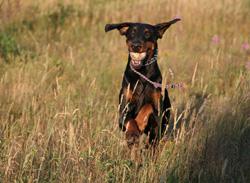German Pinschers are medium-sized, squarely-built dogs. Their coats are dense, short, and close lying and can be black, brown, blue, fawn, or red. Some have tan or red markings. Their eyes are medium, dark, and oval, and their ears are set high on their heads. These dogs have long, flat heads. German Pinschers measure 17 to 20 inches tall at the withers and weigh 25 to 45 pounds. With proper care, these dogs can live up to 14 years.
These dogs enjoy accompanying their human family members on hikes, runs, and bike rides, and they will quickly become bored and destructive if not given an outlet for their energy.
Intelligent and loyal dogs, German Pinschers make excellent companion animals. Their smaller size makes them suited for urban or country life, provided they get plenty of exercise. They are low-maintenance when it comes to grooming, which makes them a good choice for busy families.
German Pinschers played an important role in the ancestry of the Pinscher breeds, and these dogs are also closely related to Standard Schnauzers. Germans are larger than Miniature Pinschers but smaller than Dobermans.
German Pinschers are energetic, alert, determined, loyal, fearless, and intelligent dogs, and these traits make them excellent working dogs, companion animals, and watchdogs. They are best suited to families with older children, and they get along well with cats, provided they are raised together. However, these dogs have a very strong prey drive and will generally be unable to resist chasing unfamiliar cats and other small animals. Furry creatures outdoors are certain to be hunted. This breed should not be left alone with small animals.
These dogs are cuddly and sweet when indoors with their family, but they quickly become active, independent, and bold when outside. German Pinschers are wary of unfamiliar people and will show great tenacity and courage if threatened.
This breed is a very energetic one and German Pinschers need daily walks or runs as well as free time to run and play outdoors. These dogs enjoy accompanying their human family members on hikes, runs, and bike rides, and they will quickly become bored and destructive if not given an outlet for their energy. German Pinschers excel at dog sports, including obedience, agility, tracking, and rally. At home, they need to be kept in a securely fenced yard when not indoors.
German Pinschers are a healthy breed with few genetic concerns. The primary health problem these dogs face is hereditary cataracts. It's important to obtain German Pinschers from breeders who perform annual eye examinations, but routine checks must continue throughout life. Hereditary cataracts do not typically develop until dogs are several years old.
Some German Pinschers may develop Von Willebrands Disease, which is a genetic bleeding disorder. Other health concerns in this breed are mild are infrequent. Of course, no individual dog is guaranteed to be free of genetic disease, regardless of the health of the breed or family line. Attention to proper diet and regular exercise will prevent obesity and ensure a long life.
With routine veterinary care and timely vaccinations, German Pinschers typically live 12 to 14 years.
German Pinschers are intelligent and easy to train, but they are also determined and manipulative. Because of this, they will try to run the home unless trained otherwise. These dogs need to be in a home with a strong leader who is willing to put in the time to properly train and socialize them, ideally from a very young age.
To be effective, training must be consistent, firm, and fair. It must also be interesting, as this breed learns and bores quickly. It may be necessary to enlist the help of a professional trainer to prevent possessive, destructive, and manipulative behavior. This is especially true for German Pinschers taken into homes after adolescence.
These dogs have a strong prey drive that cannot be fully trained away. They are also a high-energy breed. Regular physical and mental stimulation can help prevent bad behavior and will provide an outlet for excess energy.
German Pinschers have a short coat that is easy to care for and groom. Brushing their coat with a hound mitt or natural bristle brush once or twice each week is usually enough to keep the coat clean and shiny. Seasonal shedding is not usually a significant concern with this breed, but more frequent brushing can help if shedding becomes a problem.
These dogs only need bathing every few months unless they get into something sticky or harmful. A mild canine shampoo will prevent skin irritation and dryness. A coat conditioner will brighten the coat and improve the German Pinscher's overall appearance. During bathing, the skin and coat should be examined for problems.
The nails need trimming every few weeks and the ears should be cleaned regularly and monitored for signs of infections. Any odor, redness, discharge, or pain should be reported to a veterinarian for further evaluation. Additionally, these dogs require regular dental care, including brushing and routine dental examinations. To ensure these dogs are tolerant of grooming procedures, it's important to start them early in life.
Originally from Germany, which is where the breed gets its name, the German Pinscher was highly prized for its vermin hunting abilities. These dogs were developed to guard property, hunt rats, and herd cattle. The breed's loyalty, devotion to work, intelligence, and watchfulness made it a favorite on farms.
Like so many other dog breeds, German Pinschers nearly became extinct following World War II. Fortunately, an interested owner named Werner Jung worked to bring the breed back. It was not until the late 1970s that the German Pinscher made its way to the United States.
Today, these dogs are primarily kept as family companions, and their medium size, loyalty to family, and protective personalities make them great choices for families with older children. They are also popular show dogs.
The American Kennel Club officially recognized the German Pinscher in 2003.

